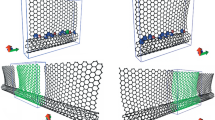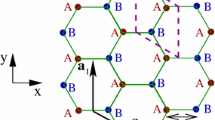Abstract
Following the recent research enthusiasm on the effect of geometry on near-field heat transfer (NFHT) enhancement, we present an analysis based on simplified yet highly efficient graphene and nanotube models. Two geometries are considered: that of two parallel infinite “graphene” surfaces and that of a one-dimensional infinite “nanotube” line in parallel with an infinite surface. Due to its symmetry, the former is in principal simpler to analyze and even so, earlier works suggested that the application of a full model in this problem still demands heavy computations. Among other findings, our simplified computation – having successfully replicated the results of relevant earlier works – suggests a sharper NFHT enhancement dependence on distance for the line-surface system, namely J ~ d−5.1 as compared to J ~ d−2.2 for the parallel surface. Such comparisons together with applications of our efficient approach would be the important first steps in the attempt to find a general rule describing geometric dependence of NFHT.
Graphical abstract

Similar content being viewed by others
References
M. Planck, Ann. Phys. 4, 553 (1901)
J.-H. Jiang, J.-S. Wang, Phys. Rev. B 96, 155437 (2017)
O. Keller, inQuantum theory of Near-Field electrodynamics (Springer, Berlin, 2011), p. 45
G.D. Mahan, Phys. Rev. B 5, 115427 (2017)
D. Polder, M. Van Hove , Phys. Rev. B 4, 3303 (1971)
S.M. Rytov,Theory of Electric Fluctuations and Thermal Radiation (Air Force Cambridge Research Center, Bedford, MA, 1953)
J.-S. Wang, Z.-Q. Zhang, J.-T. Lü, Phys. Rev. E 98, 012118 (2018)
J. Peng, H.H. Yap, G. Zhang, J.-S. Wang, https://arXiv:1703.07113 (2017)
C.M. Hargreaves, Phys. Rev. Lett. A 30, 491 (1969)
G.A. Damoto, R.F. Boehm, C.L. Tien, J. Heat Transf. 92, 412 (1970)
P. Ben-Abdallah, S.-A. Biehs, Phys. Rev. Lett. 112, 044301 (2014)
B. Liu, Y. Liu, S. Shen, Phys. Rev. B 90, 195411 (2014)
F.J.G. de Abajo, ACS Photon. 1, 135 (2014)
A.L. Fetter, J.D. Walecka,Quantum theory of Many-Particle systems (McGraw-Hill, Boston, 1971)
A.P. Jauho,Introduction to the Keldysh nonequilibrium Green function technique (2006), https://nanohub.org/resources/1877
G.D. Mahan,Many-Particle physics, 3rd edn. (Kluwer Academic, Netherlands, 2000)
H. Bruus, K. Flensberg,Many-body quantum theory in condensed matter physics (Oxford University Press, Oxford, 2004)
H. Haug, A.P. Jauho,Quantum kinetics in transport and optics of semiconductors (Springer, Berlin, 1996)
N. Ashcroft, N.D. Mermin,Solid state physics (Cengage Learning, Boston, 1976)
C. Caroli, R. Combescot, P. Nozieres, D. Saint-James, J. Phys. C 4, 916 (1971)
Y. Meir, N.S. Wingreen, Phys. Rev. Lett. 68, 2512 (1992)
P.R. Wallace, Phys. Rev. 71, 662 (1947)
A.H. Castro Neto, F. Guinea, N.M.R. Peres, K.S. Novoselov, A.K. Geim, Rev. Mod. Phys. 81, 109 (2009)
E.H. Hwang, S. Das Sarma, Phys. Rev. B 75, 205418 (2007)
R.S. Deacon, K.-C. Chuang, R.J. Nicholas, K.S. Novoselov, A.K. Geim, Phys. Rev. B 76, 081406(R) (2007)
S. Reich, J. Maultzsch, C. Thomsen, P. Ordejón, Phys. Rev. B 66, 035412 (2002)
D. Bohm, D. Pines, Phys. Rev. 82, 625 (1951)
J. Lindhard, Kgl. Danske Videnskab. Selkab Mat.-fys. Medd. 28, 8 (1954)
B. Wunsch, T. Stauber, F. Sols, F. Guinea, New J. Phys. 8, 318 (2006)
B. Mihaila, https://arXiv:1111.5337 (2011)
R. Yu, A. Manjavacas, F.J. García de Abajo, Nat. Commun. 8, 2 (2017)
L.V. Keldysh, Sov. Phys. JETP 20, 1018 (1965)
J. Peng, J.-S. Wang, https://arXiv:1805.09493 (2018)
Author information
Authors and Affiliations
Corresponding author
Additional information
Publisher’s Note
The EPJ Publishers remain neutral with regard to jurisdictional claims in published maps and institutional affiliations.
Rights and permissions
About this article
Cite this article
Lian, K.N., Wang, JS. Geometric effect on near-field heat transfer analysis using efficient graphene and nanotube models. Eur. Phys. J. B 93, 138 (2020). https://doi.org/10.1140/epjb/e2020-10164-8
Received:
Revised:
Published:
DOI: https://doi.org/10.1140/epjb/e2020-10164-8




